Unfortunately, the worst cat food brands are also the most popular brands – Purina, Friskies, Royal Canin, Blue Buffalo, Hill’s, etc.
Vets recommend them, and other cat-focused blogs will say that they are “AAFCO-approved,” which doesn’t exist.
AAFCO doesn’t approve, certify, endorse, or test cat food. Instead, they make guidelines for pet food companies to follow when making the food and the label. More on that below.
The cat food brands I avoid are made with low-quality meat ingredients, very high amounts of carbs, synthetic nutrients, and carcinogenic preservatives.
These brands are also owned by the same companies that make junk food for humans. So if these brands make junk food for humans, how can their cat food be healthy?
I’ve learned this the hard way over and over again with cats growing up who all ate these awful foods.
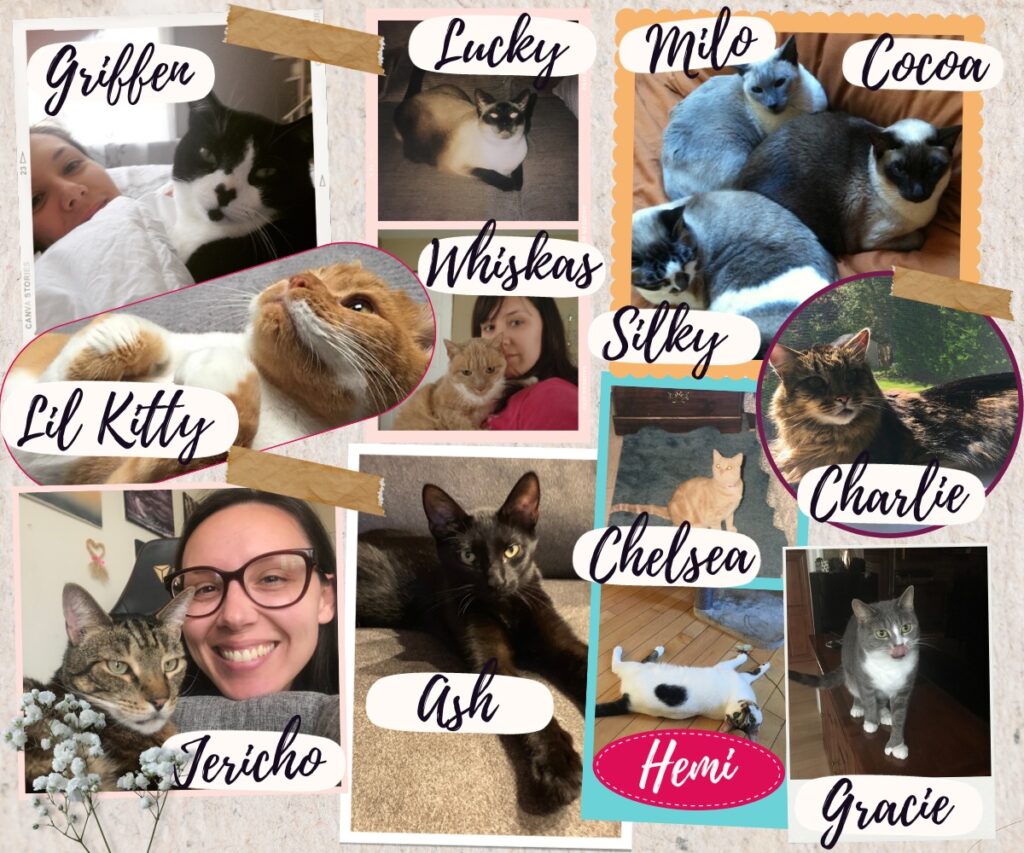
Chelsea got diabetes and died at 10, Milo had liver disease, Lucky had cancer and only lived to 8, Cocoa was obese and died suddenly at 10 because he was dehydrated, and the list goes on.
The last cat we had to put down, Hemi, was only 3.5 years old! Kidney failure.
And I realized my cats weren’t the only ones suffering when I worked as a cat sitter for 3 years. Many of my clients required pills, insulin, fluids, etc. What was the common theme? These brands.
So now it’s my mission to help cat parents cut through the BS on the label so they can find cat food that’s actually worth their money AND supports their cat’s health.
No more supporting these multi-billion-dollar “big pet food” brands that clearly do not care about our cat’s health.
This is exactly why I recommend a healthy raw diet for cats as a pet nutritionist. Raw is a much more natural diet than the garbage that these brands make.
But I understand not everyone is on board with raw at first, and that’s ok. There are healthy, gently cooked diets as well. More on this below. And you can read more about my experience and credentials here.
These are the worst cat food brands:
- Mars Petcare cat food brands (Royal Canin, Sheba, Whiskas, Iams, Nutro, Temptations, Greenies)
- Nestle cat food brands (Friskies, Fancy Feast, Beyond, Deli Cat, Muse, Kit & Kaboodle, Kitten/Cat Chow, Purina ONE, Purina ProPlan, Purina ProPlan Veterinary Diet)
- JM Smucker cat food brands (Rachel Ray Nutrish, 9Lives, MeowMix, Natural Balance)
- Colgate-Palmolive cat food brands (Hill’s Science Diet)
- General Mills cat food brands (Blue Buffalo, Blue Wilderness, Blue Basics, Blue Carnivora, Blue True Solutions, Blue Freedom, Blue Natural Veterinary Diet)
Before you read the rest…
At the end of the day, YOU are responsible for your cat. And YOU have the option to feed or avoid whatever you want.
Just like these brands have the option to produce these garbage foods.
Additionally, cats are sensitive to diet changes. Transition cat food slowly if you decide to change the food.
And yes, I agree that ANY wet food (that’s complete and balanced) is better than ALL dry foods. Simply because wet food has high moisture. But most people who find me want to feed the absolute healthiest diet possible. If that’s you, keep reading.
I’m reporting the facts, based on these 4 things:
1. Cat food manufacturer
Not just the brand. But who is actually MAKING the product.
2. AAFCO product name rules
AAFCO cat food label rules tell us the minimum and maximum amount of the named ingredients.
3. AAFCO ingredient definitions
AAFCO states that meat by-products can include 4D meats (dead, diseased, dying, disabled) as long as the by-products are rendered. Meat meals are rendered meats.
According to a CRS Report to Congress on animal rendering, rendered meats can include dead animals from feedlots, ranches, marketing barns, ANIMAL SHELTERS, and food waste from restaurants, groceries, and stores.
4. Guaranteed analysis
The NRC says that carbohydrates are not essential to the cat’s diet. AAFCO and FEDIAF also do not set minimum requirements for carbohydrates. Unfortunately, AAFCO does not require carbohydrates on the guaranteed analysis.
So you must use a carb calculator and then convert to a dry matter basis to figure this out yourself.
If you don’t understand these facts, you will not understand this article. I get many comments about this article. But these are the facts.
Please educate yourself on AAFCO labeling requirements and definitions. And heavily research the company that’s making your cat’s food (not just the brand name).
I realize this is a long introduction and a long post. But it’s a touchy subject. And I want you to know that I’m not here to only point out the bad.
I have much more content about the best brands and how to give your cat a happy and healthy life. But “worst cat food brands” is searched and viewed over 3.5 times more than “best cat food brands” based on my analytics.
This post has been the highest viewed on my website and YouTube for years. So I’m putting it all in here because then more cat parents will finally have the solution and not just a list of the worst brands.
If you’d like to jump straight to the best way to feed your cat, here it is:
- Learn about cat nutrition and how to read cat food labels so you don’t have to rely on me or anyone else to tell you what to feed your cat (I understand not everyone has time for this so skip to the next step if that’s you)
- Choose from the best high protein low carb wet food list (if you’re not comfortable with raw)
- Read through my raw feeding cats guide (if you are ready for raw) to see which raw diet is best for you.
- Use my how to transition cat food guide so your cat actually eats the new food you buy
PS – If you’re ready to switch to a healthy raw diet, my Raw Feeding Blueprint is for you!
I’ve created the most supportive plan inside this course! Think, every week is planned out for you with printable trackers, 50+ balanced recipes to choose from, meal prep hacks, and so much more. If you’re ready to make your cat’s raw food at home, my Raw Feeding Blueprint course is for you!
I also want to mention that feeding your cat a healthy diet does not have to be expensive. It may seem more costly at first. But try to think about long-term savings.
You may spend more money now on healthier food, but you’re more likely to save a lot of money on expensive vet bills later down the road. Not to mention the stress and potential heartache.
I still recommend reading through the rest of this post to see why these brands are the worst because this will motivate you to switch to a healthier brand.
Mars Petcare cat food brands (Royal Canin, Sheba, Whiskas, Iams, Nutro, Temptations, Greenies)
Mars is a major conglomerate corporation that owns dozens of brands (human food and pet food).
You’re probably familiar with candy bars, gum, and frozen foods made by Mars.
M&Ms, Tasty Bites, Big Red, Combos, etc.
Let’s look at their cat food.
Royal Canin
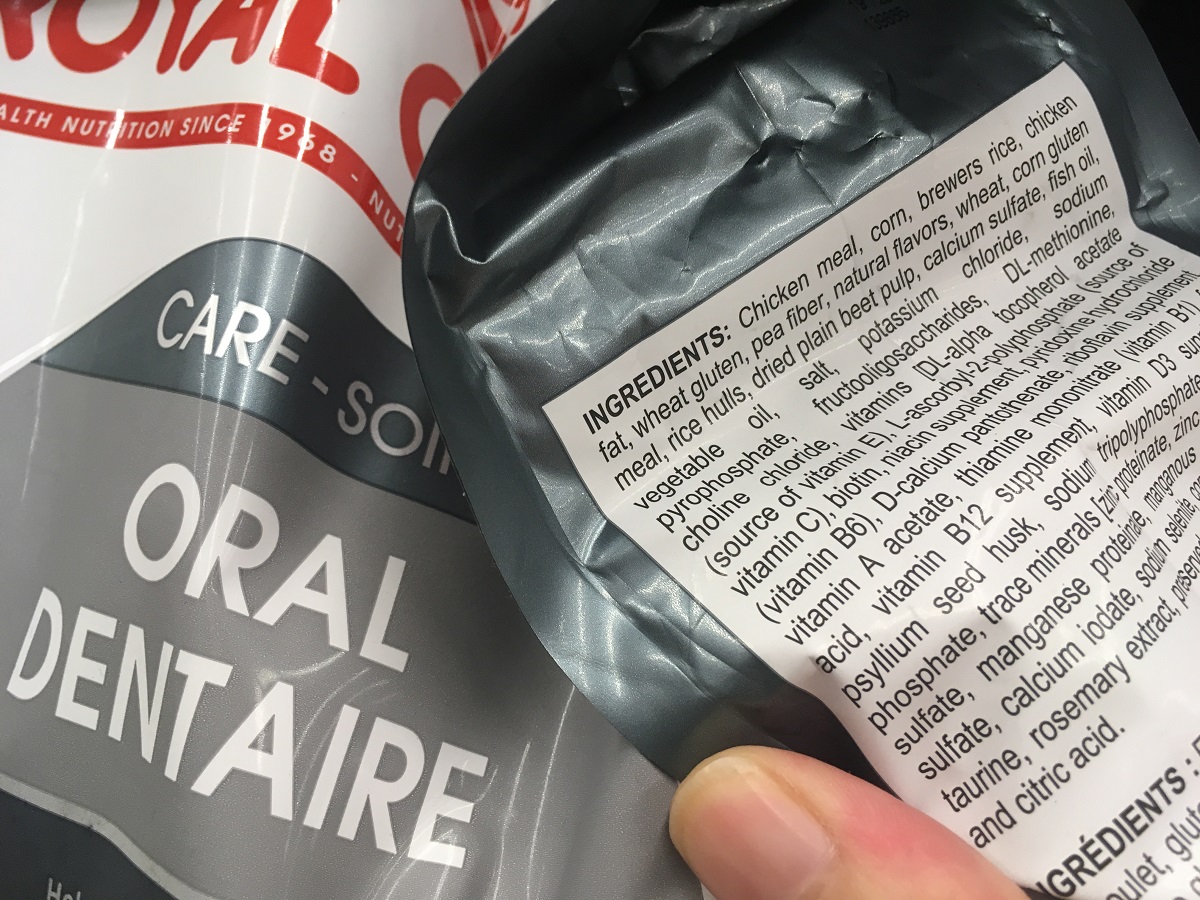
- Product name rule = no rule, no minimum requirement of meat
- Carb amount = approx 46% dry matter basis
- First 5 ingredients = Chicken meal, corn, brewers rice, chicken fat, wheat gluten
This food is marketed as oral care. It says it helps reduce dental plaque.
3 of the first 5 ingredients are carbohydrates. And almost half the food is made from carbohydrates.
Cats can’t produce amylase in their saliva. Amylase breaks down carbohydrates.
So cats can’t break down carbohydrates in their mouth. How can carbohydrates promote healthy cat teeth?
Also, there’s not much whole meat in this product.
Cats need meat to survive and thrive.
Additionally, phosphates and pyrophosphates are typically used as pet food flavor enhancer “palatants”. There are multiple phosphates in this product.
A study has shown that these inorganic phosphates, when given in excess, can cause renal issues in cats.
And this is a vet-recommended brand…
Greenies
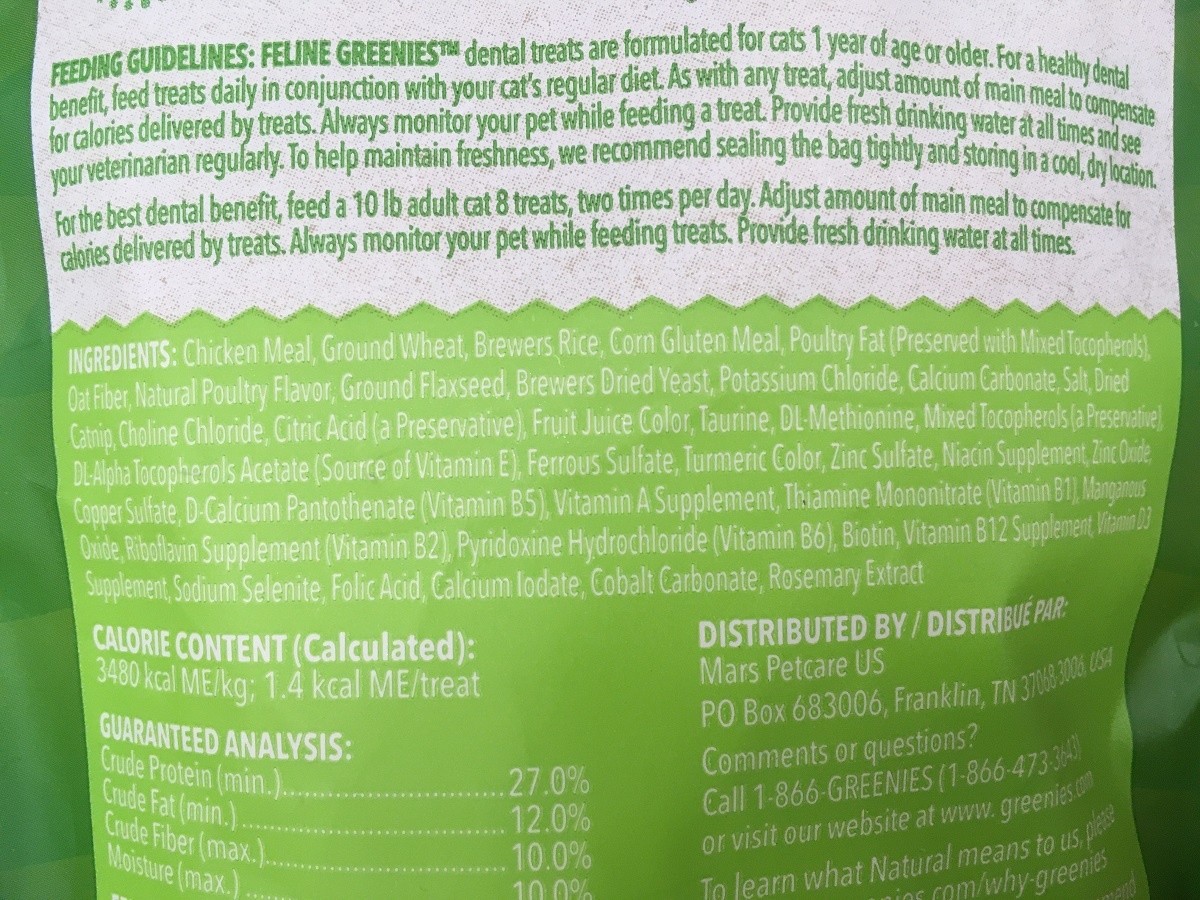
- Product name rule = flavor rule, no minimum requirement of meat
- Carb amount = approx 48% dry matter basis
- First 5 ingredients = Chicken meal, ground wheat, brewers rice, corn gluten meal, poultry fat
Greenies technically isn’t food. But a lot of vets recommend it for dental care.
These treats have even more carbohydrates. And again we see not much meat in the product.
Notice that the first 5 ingredients are almost identical to the “oral care” product mentioned above?
Check the label and you’ll see Mars Petcare US.
Temptations
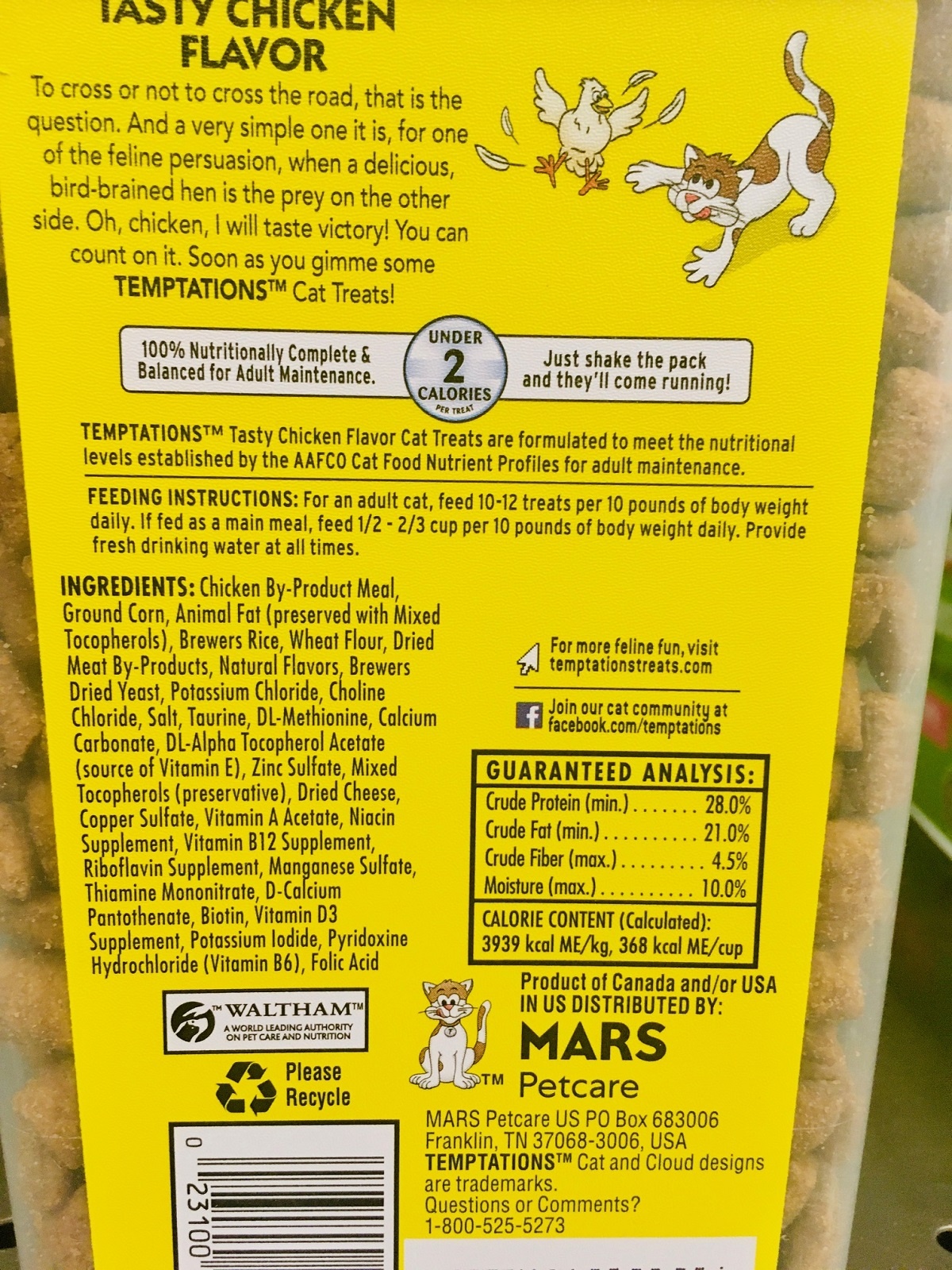
- Product name rule = flavor rule, no minimum requirement of meat
- Carb amount = approx 37% dry matter basis
- First 5 ingredients = Chicken by-product meal, ground corn, animal fat, brewers rice, wheat flour
Temptations actually list feeding instructions.
Please, do not feed these to your cat. Avoid it as treats and as food.
Seriously. I cannot believe they recommend feeding this as a meal.
Again, we see the same first 5 ingredients.
The product name includes the words “chicken flavor”.
That means the product has no minimum requirement for chicken. And that minimum is guaranteed less than 3%.
If it contained at least 3% chicken, the product name would say “with chicken” instead of “chicken flavor”.
This is why learning cat food label rules is so important!
And you’ll see a big Mars Petcare on the label.
Nestle cat food brands (Friskies, Fancy Feast, Beyond, Deli Cat, Muse, Kit & Kaboodle, Kitten/Cat Chow, Purina ONE, Purina ProPlan, Purina ProPlan Veterinary Diet)
Nestle is responsible for almost half the cat food brands on the market today.
Did you know this?
They’re also responsible for junk cereal, drinks, and chocolate.
Let’s look at their cat food.
Friskies wet
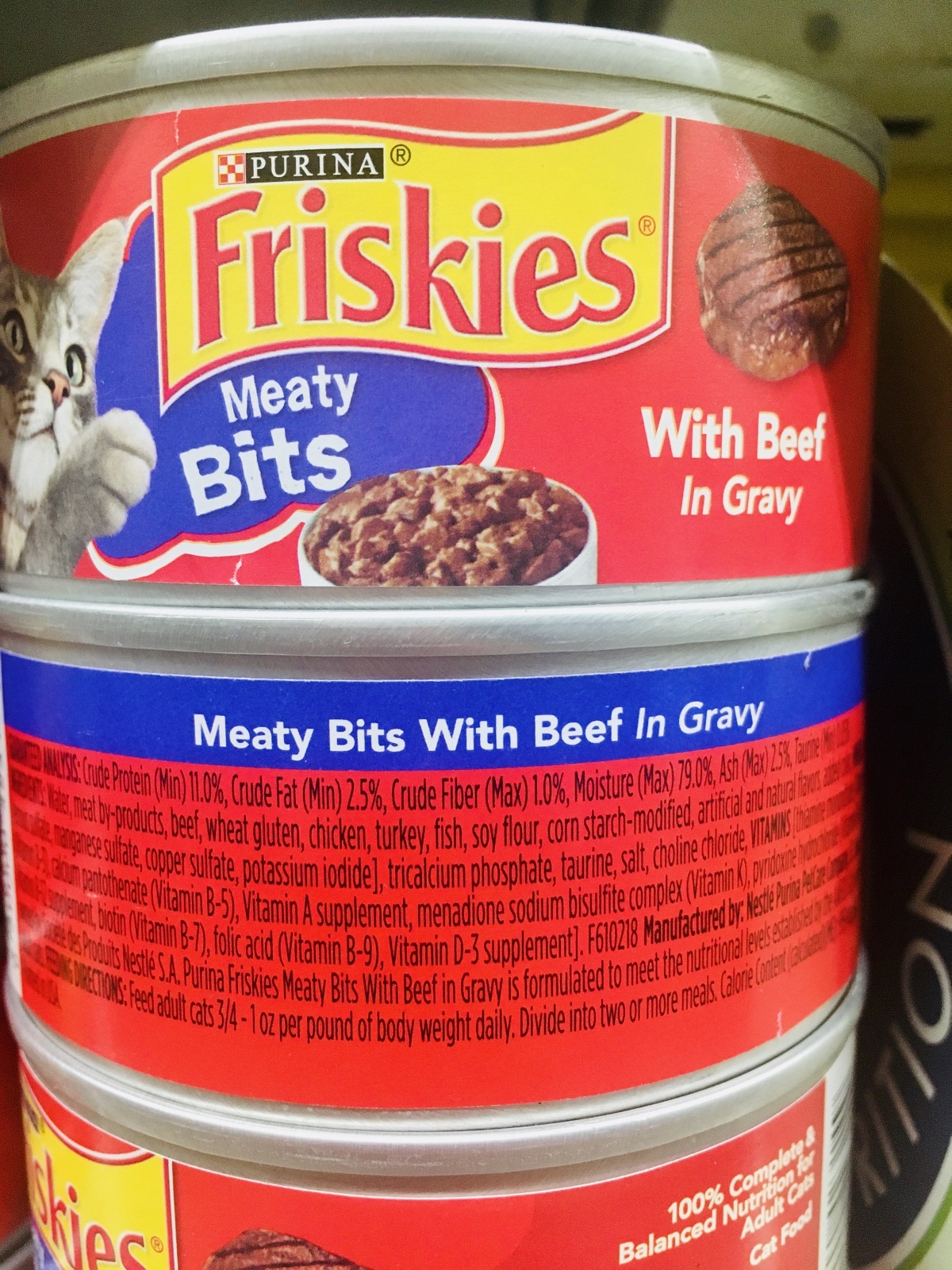
- Product name rule = with rule, 3% minimum requirement of meat
- Carb amount = approx 23% dry matter basis
- First 5 ingredients = Water, meat by-products, beef, wheat gluten, chicken
The name is “with beef in gravy”. The label shows a slice of beef.
Would you suspect chicken to be in this food? What about turkey and fish?
What about meat by-products? We have no idea what type of animal that is. And we have no idea what type of by-products this is.
During the slaughter and meat-cutting process, certain carcasses or parts may be rejected for human use and can be expected to be processed into animal feed. This may include meat that doesn’t meet aesthetic standards, or internal organs or other parts that normally aren’t used for human food.
AAFCO.
So by-products are leftovers that aren’t good enough for human consumption.
I agree that organs and bones are very nutritious for cats. My cat eats 100% raw including raw meaty bones, muscle meats, organs, and occasional whole prey.
But let’s think about it like this…
I can buy animal parts like liver, kidney, pig ears, chicken feet, pig skin, turkey tails, cow feet, entire rabbits, lamb heads, etc. at my local grocery store.
So what type of leftovers are going into cat food?
How do we know “meat by-products” in cat food are actually clean sources of these secondary products?
The manufacturer doesn’t even know what type of meat and what type of by-products they are using. So how can we know what it is?
Good-quality cat food products will list the exact meat and the by-products by name. The ingredients will read beef heart, beef liver, beef kidney, beef tripe, beef bones, etc.
So why do some products list the exact meat ingredients and others just say meat by-products?
Friskies dry
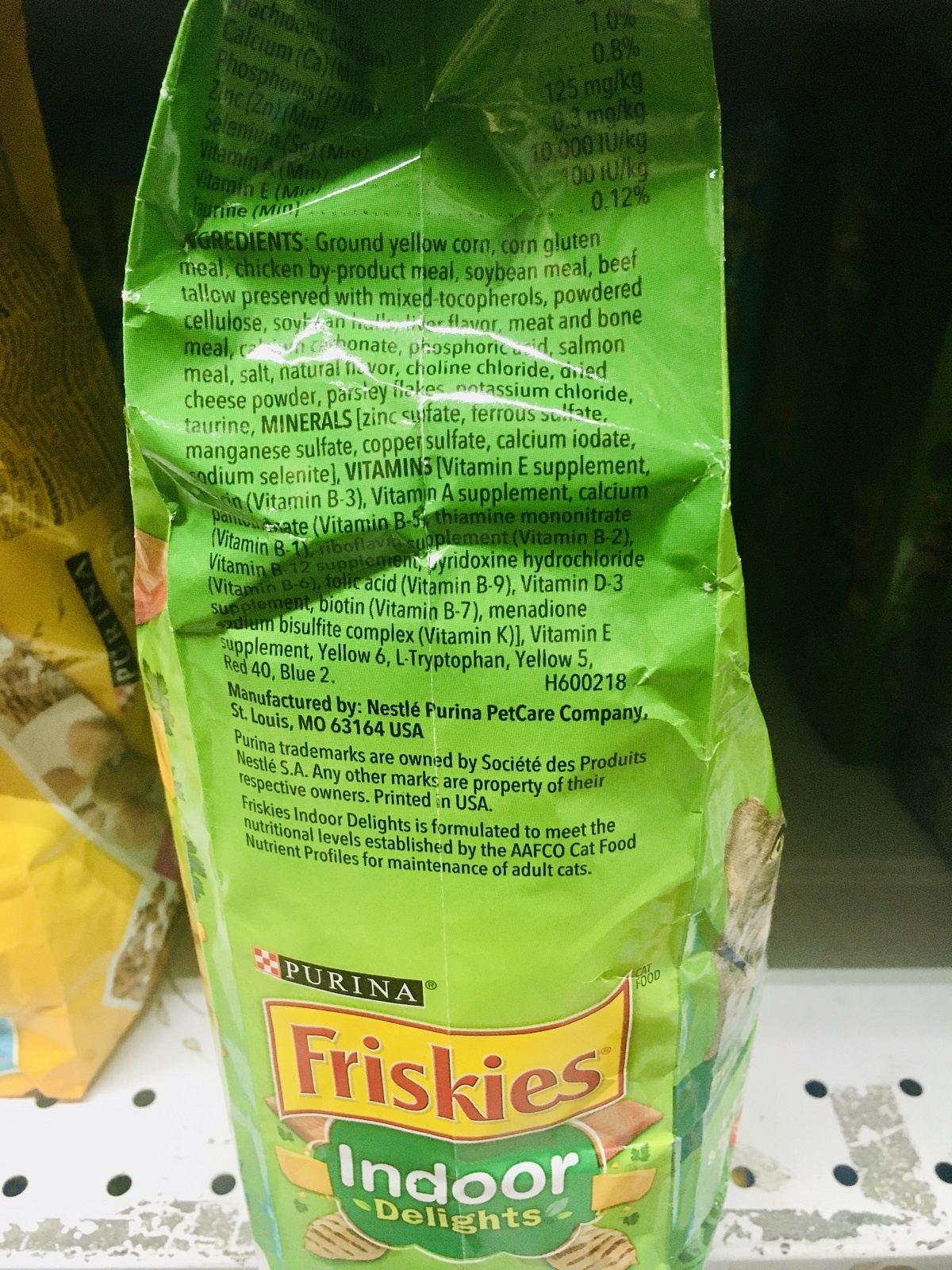
- Product name rule = flavor rule, no minimum requirement of meat
- Carb amount = approx 47% dry matter basis
- First 5 ingredients = Ground yellow corn, corn gluten meal, chicken by-product meal, soybean meal, beef tallow
There’s no actual meat in this product! And 3 out of 5 first ingredients are carbohydrates.
Not suitable for cats.
There’s also soy and powdered cellulose both of which are cheap fillers and can cause digestive upset.
Further down the list, you’ll see color additives yellow 5, yellow 6, and red 40.
These color additives can damage DNA cells and contribute to cancer.
Fancy Feast
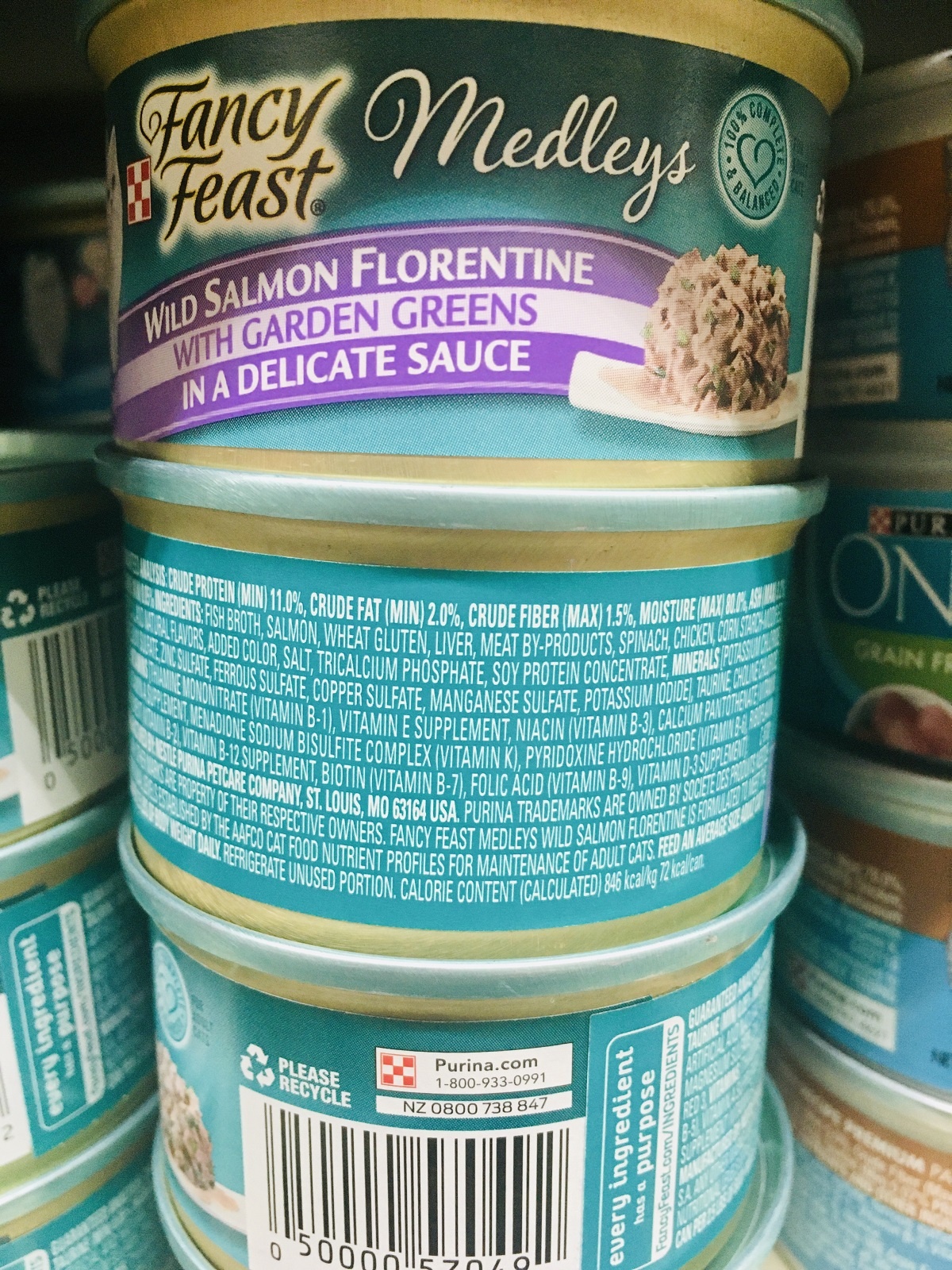
- Product name rule = no rule, no minimum requirement of meat
- Carb amount = approx 19% dry matter basis
- First 5 ingredients = Fish broth, salmon, wheat gluten, liver, meat by-products
3 out of the first 5 ingredients are mystery meats.
What type of fish is used for the fish broth?
Where did the liver come from?
What type of meat by-products are in this food? Is it chicken? Pork? Beef? Turkey? Lamb?
Do you see what I mean?
We have absolutely no idea what type of meat is in this product.
And going back to the CRS Report for Congress, it could include dead animals from animal shelters.
Scary, I know. But we have no idea what it actually includes because the manufacturer doesn’t tell us.
Purina ONE
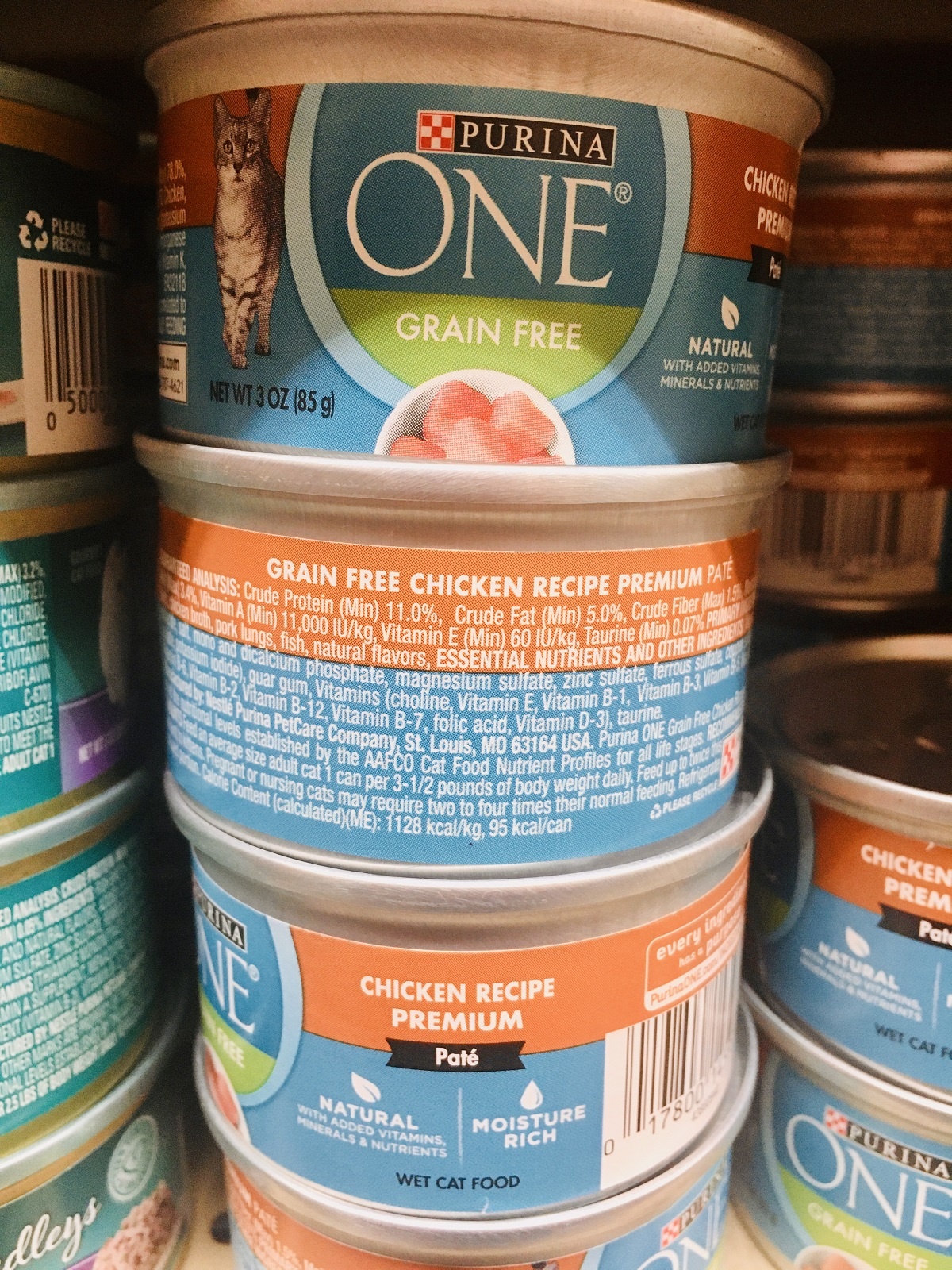
- Product name rule = recipe rule, 25% minimum requirement of meat
- Carb amount = approx 11% dry matter basis
- First 5 ingredients = Chicken, liver, broth, pork lungs, fish
Again we have some mystery ingredients.
Where did the liver and broth come from? What type of fish?
You’ll notice it says “premium” on the label.
Guess what?
Premium is a totally unregulated term in feed law… Premium pet food doesn’t have special requirements that differ from any other pet food.
AAFCO
All US pet food manufacturers have to follow AAFCO’s guidelines and definitions when creating and labeling their products.
So they know that the word “premium” doesn’t mean anything. So why would they bother using it on the label?
Purina ProPlan
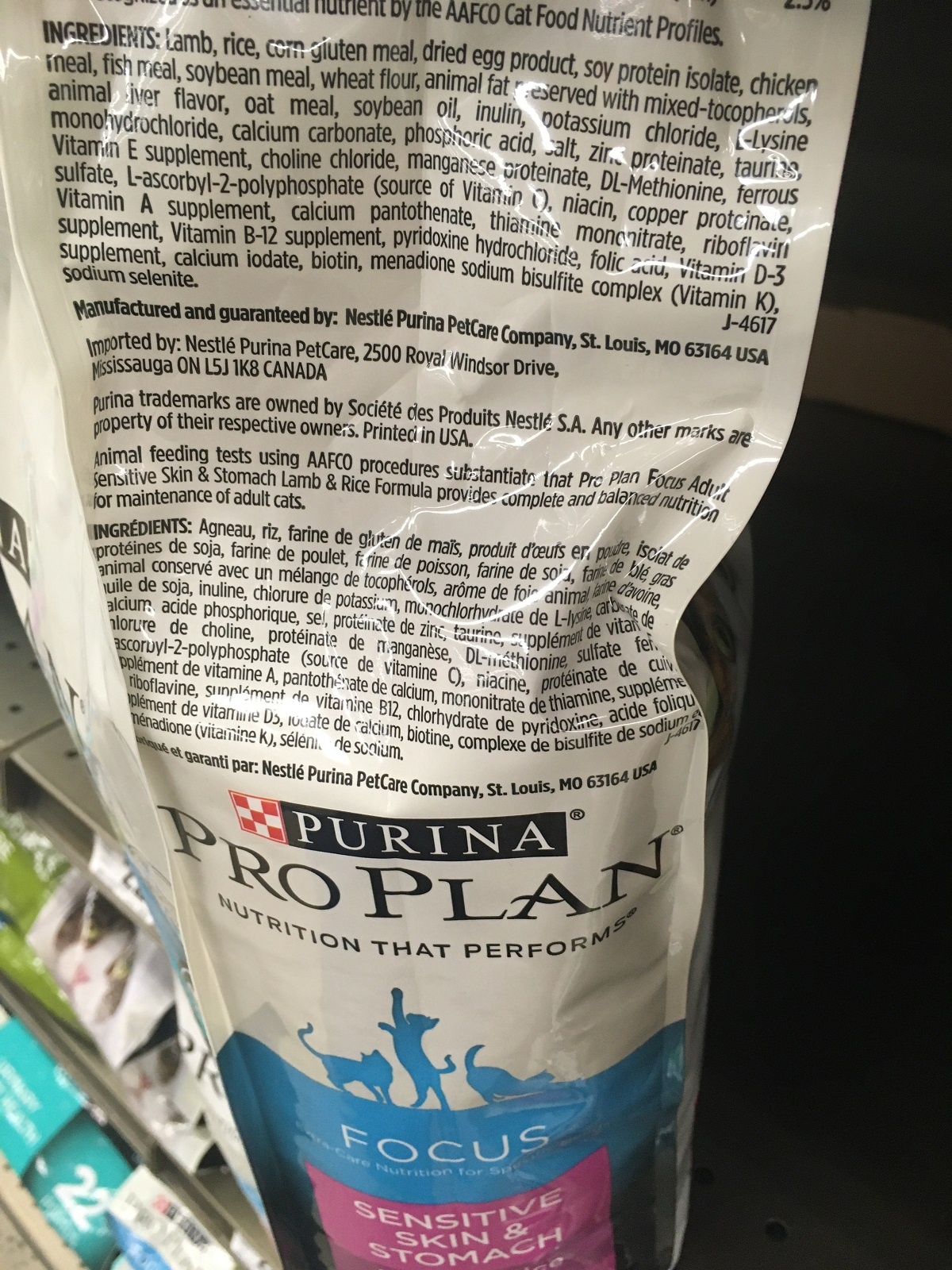
- Product name rule = formula rule, 25% minimum requirement of meat and rice combined
- Carb amount = approx 27% dry matter basis
- First 5 ingredients = Lamb, rice, corn gluten meal, dried egg product, soy protein isolate
I’m sure you’re thinking, “but lamb is the first ingredient”.
Ingredients must be listed in predominance by weight.
When it’s added to the food.
The USDA states muscle meat is approximately 75% moisture.
Moisture is removed during the 3 cooking (extrusion) processes in which kibble is made.
So 75% of that lamb is gone by the time the kibble is done.
Carbohydrates, however, are already dried when they’re added to kibble.
So again most of what you’re buying is carbohydrates your cat isn’t designed to digest.
If cats cannot digest a lot of these ingredients, how can this be good for a sensitive stomach?
JM Smucker cat food brands (Rachel Ray Nutrish, 9Lives, MeowMix, Natural Balance)
JM Smucker is another conglomerate that has its hands in pet food.
I’m sure you’re familiar with some of their brands like Dunkin Donuts, Crisco, and Jif.
Let’s take a look at their cat food…
Rachel Ray Nutrish
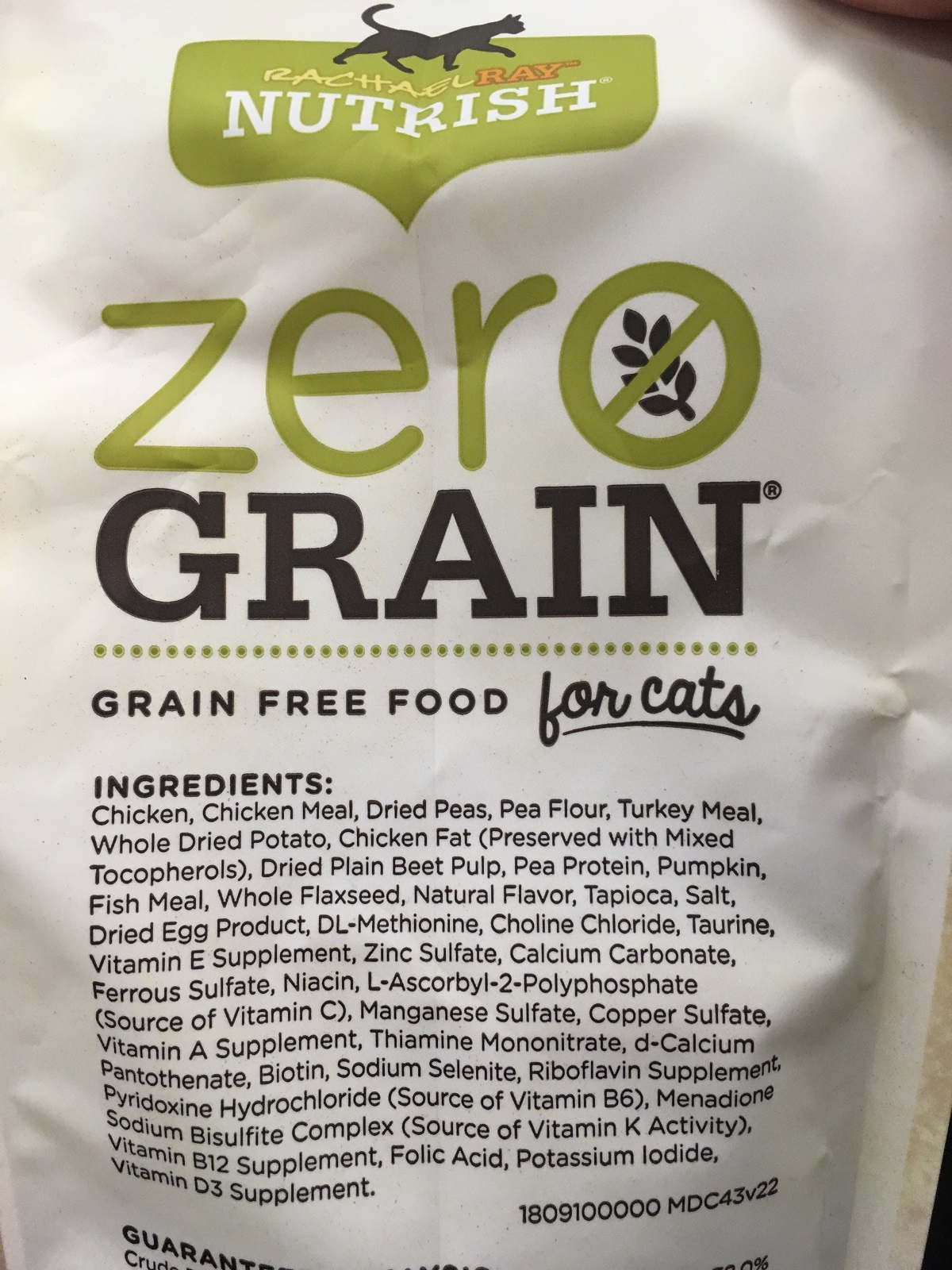
- Product name rule = recipe rule, 25% minimum requirement of meat and potato combined
- Carb amount = approx 39% dry matter basis
- First 5 ingredients = Chicken, chicken meal, dried peas, pea flour, turkey meal
This product is marketed as grain-free.
But approximately 39% of the product comes from carbohydrates.
Grain-free does not mean carb-free.
Potatoes, peas, and pumpkin all contribute carbohydrates.
Not to mention, there are several class-action lawsuits against Rachel Ray pet food.
One of her dog foods actually contained dog DNA. Among a long list of other animals that were not listed in the ingredients.
9Lives wet
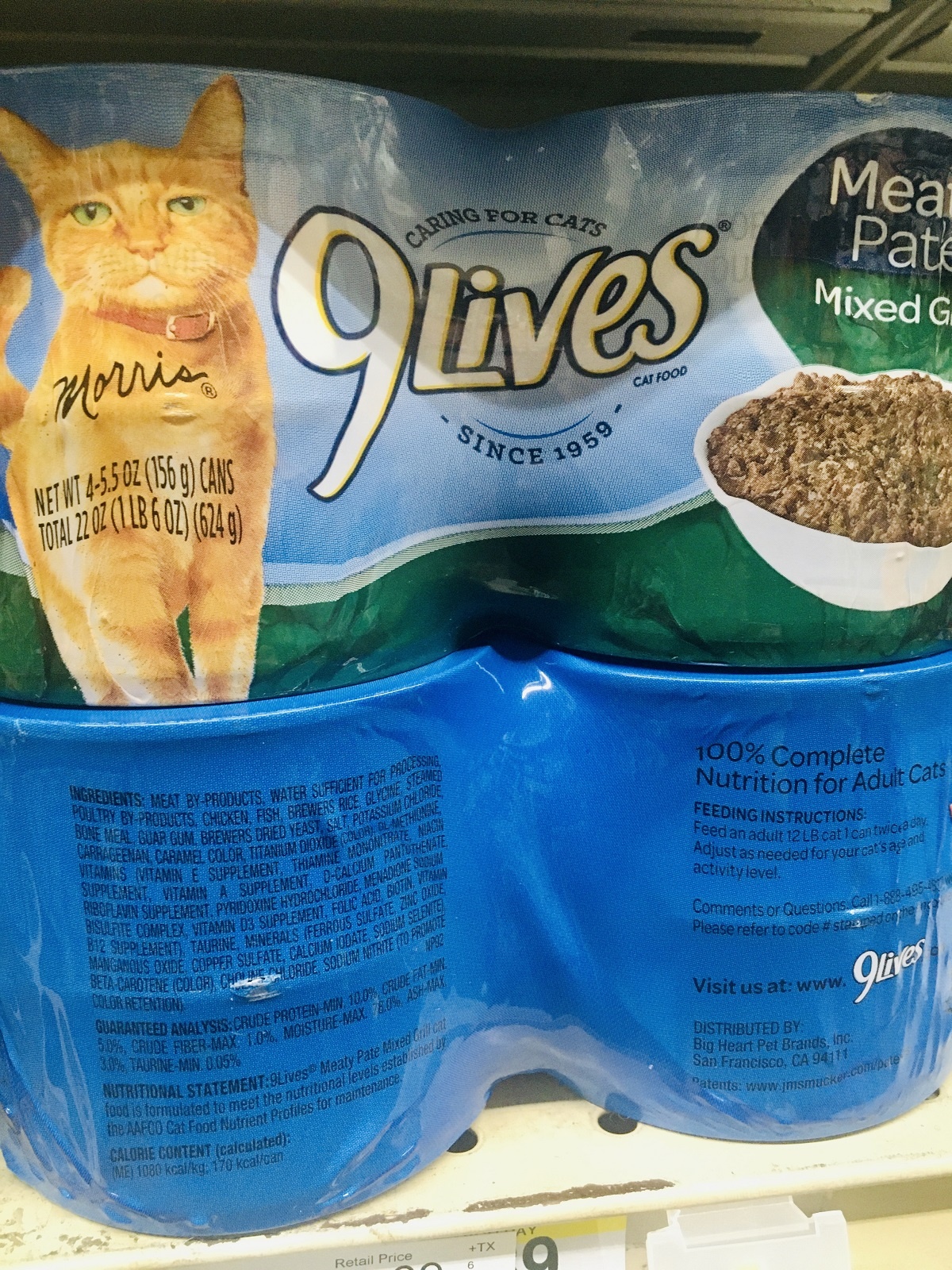
- Product name rule = no rule, no minimum requirement of meat
- Carb amount = approx 18% dry matter basis
- First 5 ingredients = Meat by-products, water, poultry by-products, chicken, fish
We have more mystery meats!
What type of meat? What type of by-products?
Which kind of poultry?
What type of fish?
9Lives dry
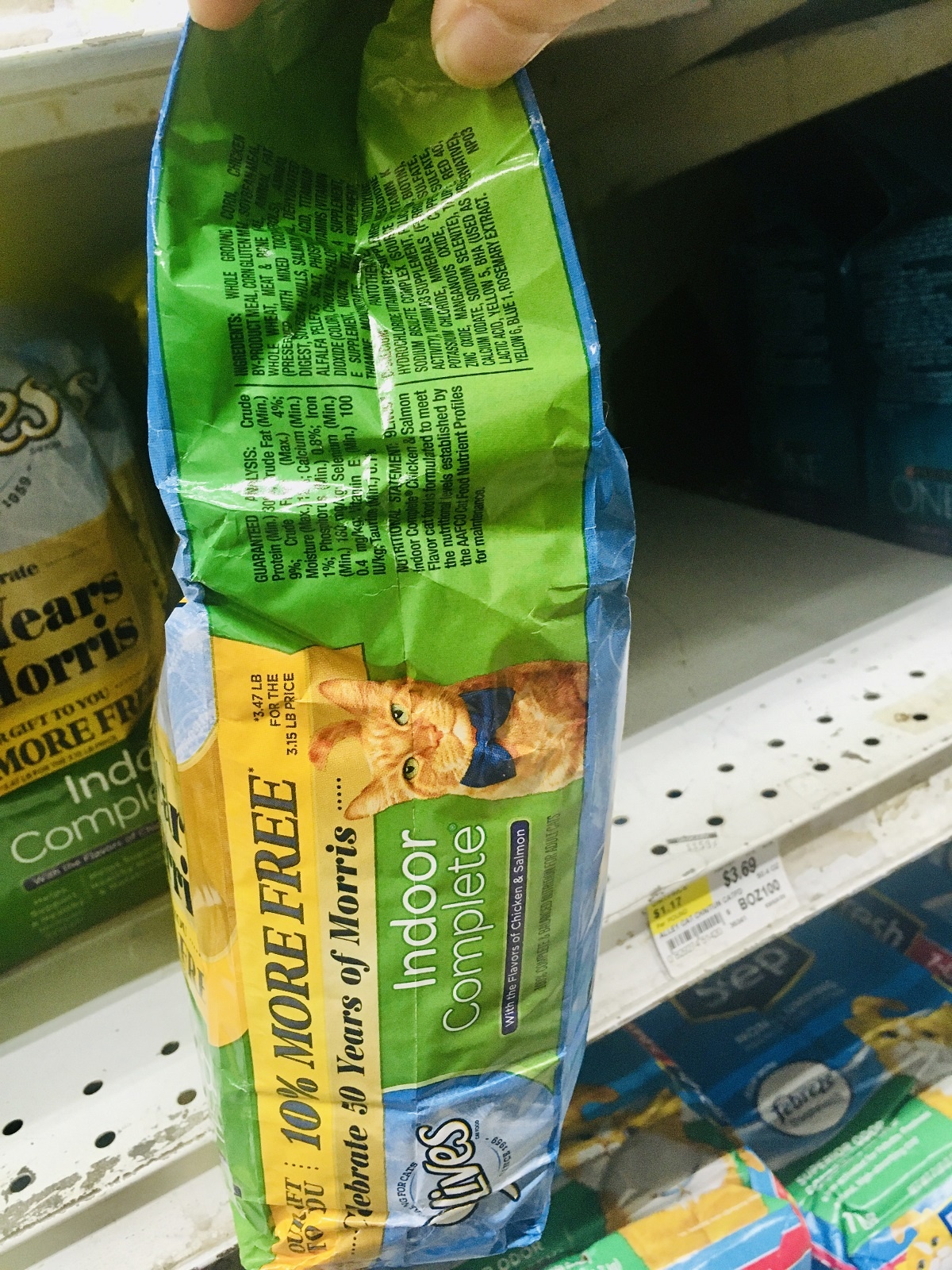
- Product name rule = with rule, 3% minimum requirement of meat
- Carb amount = approx 47% dry matter basis
- First 5 ingredients = Whole ground corn, chicken by-product meal, corn gluten meal, soybean meal, whole wheat
Almost 50% carbohydrates.
And 4/5 first 5 ingredients are carbohydrates.
MeowMix
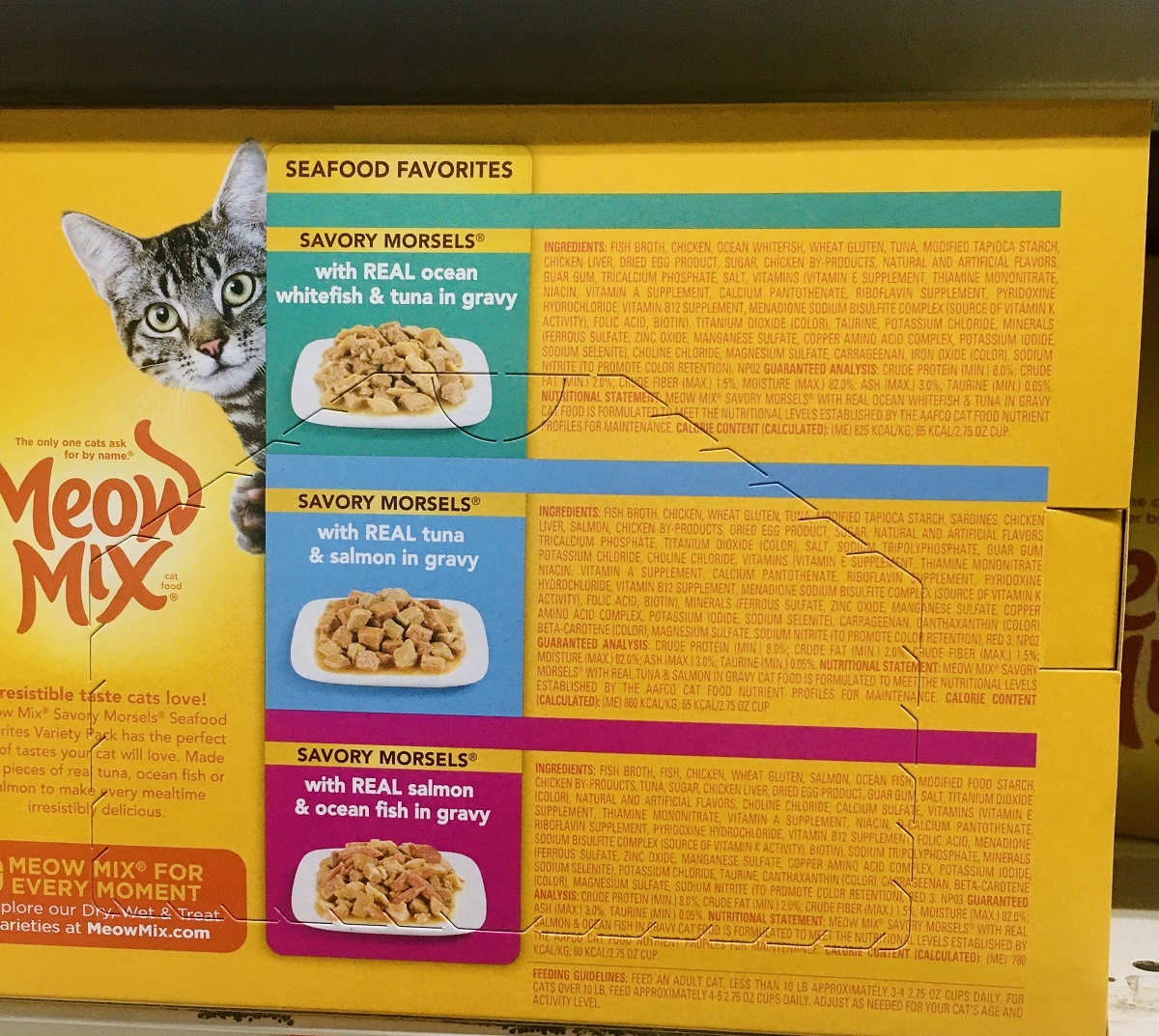
- Product name rule = with rule, 3% minimum requirement of meat
- Carb amount = approx 27% dry matter basis
- First 5 ingredients = Fish broth, chicken, fish, wheat gluten, ocean fish
The first 5 ingredients vary with each product in this variety pack.
But the first ingredient in all of them is…
Mystery meat!
Fish broth? What kind of fish?!
A few other questionable ingredients include sugar, guar gum, carrageenan, modified food starch, and the list goes on.
Carbs break down into sugar. And sugar fuels obesity and related diseases.
Colgate-Palmolive cat food brands (Hill’s Science Diet)
Colgate-Palmolive owns Hill’s Pet food.
Hill’s Pet is popular because it’s “vet-recommended” cat food.
In 2007, Colgate breached advertising laws in their claim “80% of dentists recommend Colgate”.
The advertising claim made it seem like Colgate was recommended 80% of the time over other brands.
But the survey actually asked dentists and hygienists to recommend several brands.
Additionally, the dentists and hygienists that participated in the survey were unaware that the survey was being conducted by Colgate.
So what does this have to do with cat food?
Well, Colgate-Palmolive uses the same clever marketing to sell Hill’s Science Diet cat food.
It says it right on the label: veterinarian recommended.
Some of Hill’s Pet foods are even prescription diets.
By the way, Hill’s Pet trademarked the term “prescription diet” as part of their logo.
And there are class action lawsuits against the company because the products don’t actually contain any prescription medicine.
Hill’s Prescription Diet
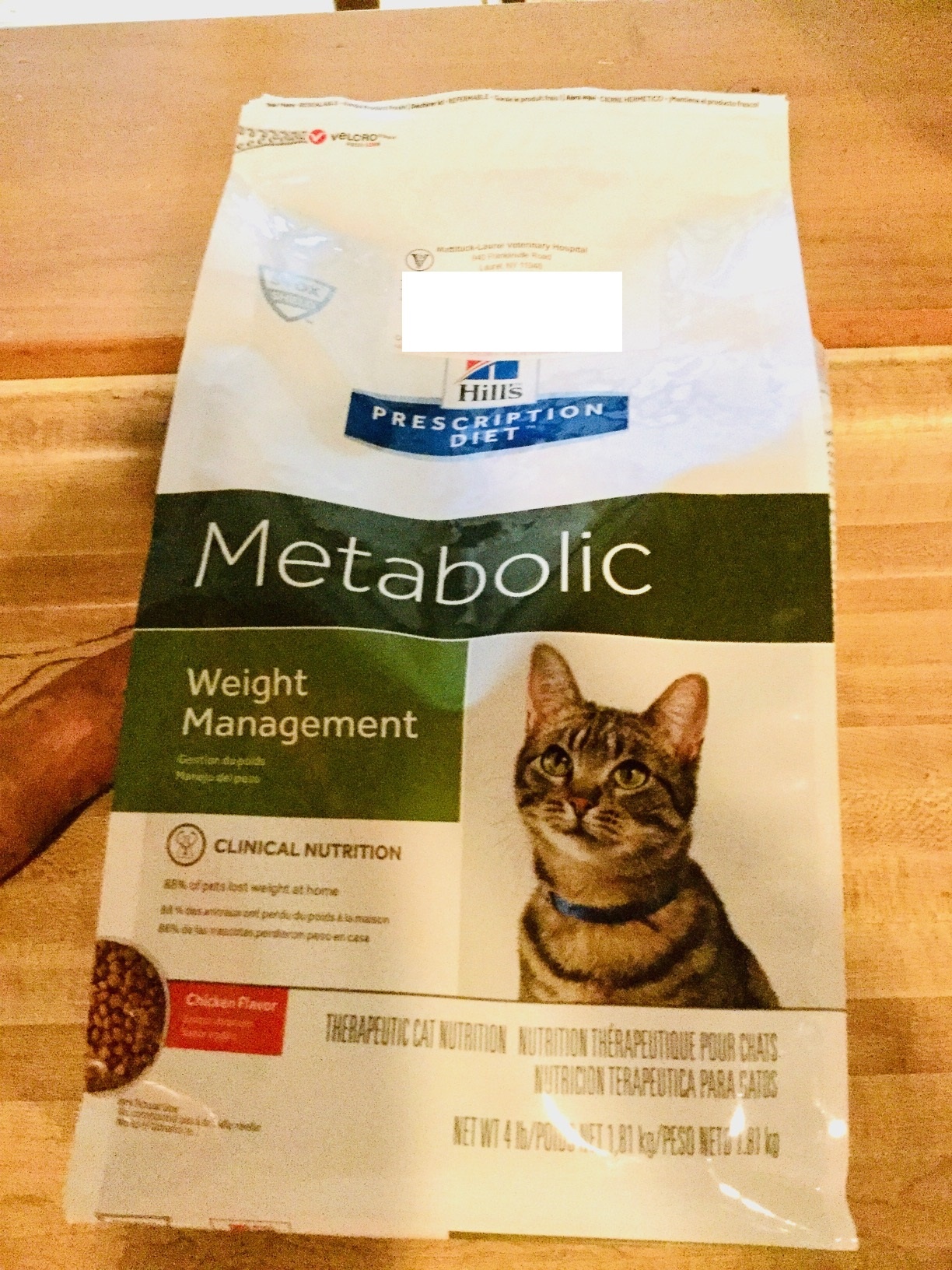
- Product name rule = flavor rule, no minimum requirement of meat
- Carb amount = approx 31% dry matter basis
- First 5 ingredients = Chicken by-product meal, brewer’s rice, corn gluten meal, powdered cellulose, dried tomato pumice
No actual meat in this food.
According to AAFCO’s cat food label rules, there’s no minimum requirement of chicken.
If there were at least 3% chicken in this product, the name would be “with chicken” instead of “chicken flavor”.
Additionally, AAFCO states that by-product meals are rendered meats.
This specific prescription is for weight management. But if cats store excess carbs as fat, how can this be good for weight management?
And you need a prescription for this product…
Hill’s Wet
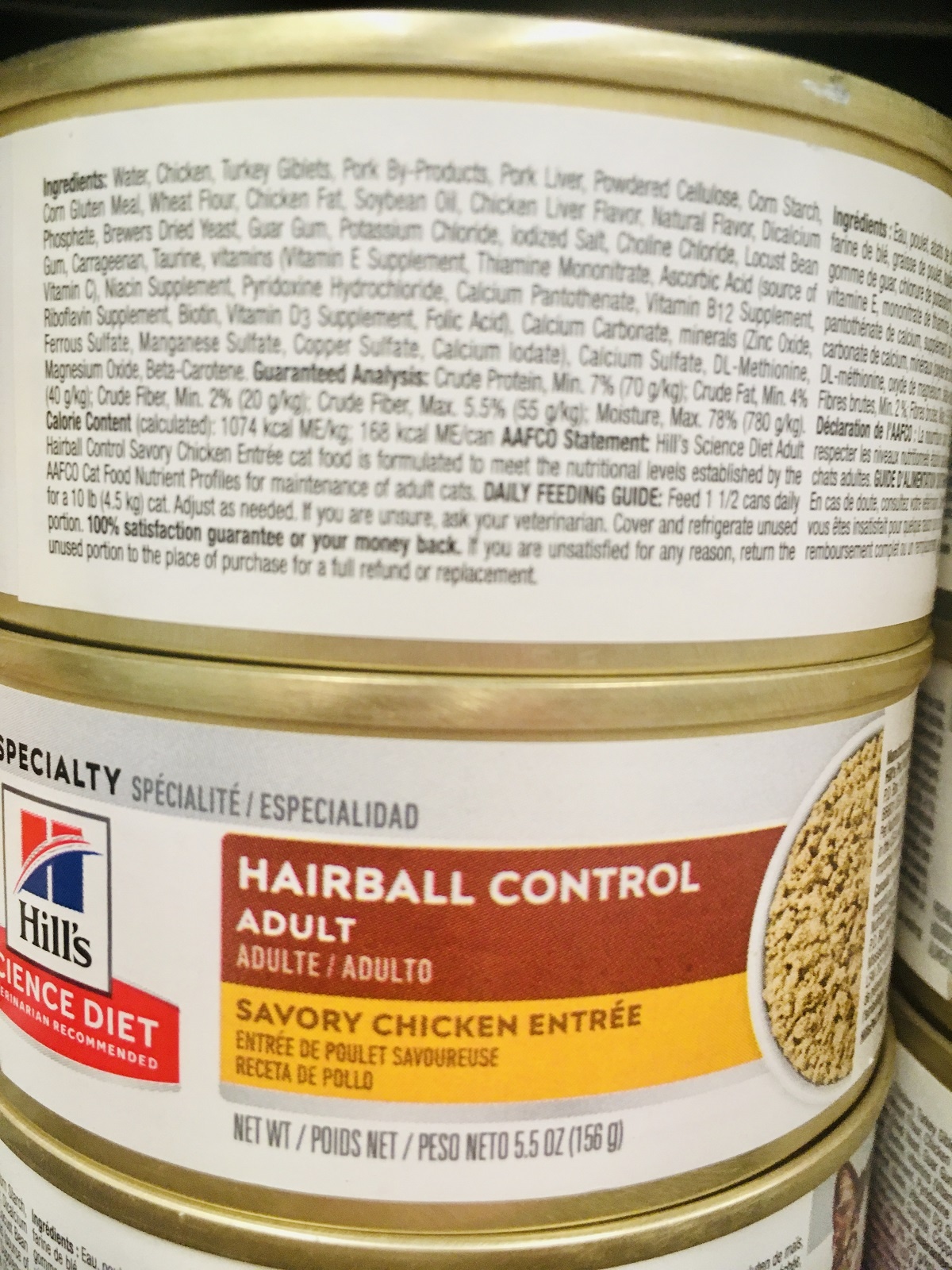
- Product name rule = entree rule, 25% minimum requirement of meat
- Carb amount = approx 43% dry matter basis
- First 5 ingredients = Water, chicken, turkey giblets, pork by-products, pork liver
We see more by-products.
By the way, some people love to tell me that by-products aren’t that bad. But again, I can buy pork by-products at the grocery store. We have no way of knowing what type of by-products are used in cat food and how clean they are.
This is for hairball control, but the rest of the ingredients aren’t good for digestion.
Powdered cellulose, corn starch, corn gluten meal, wheat flour, brewers dried yeast, etc.
How can this help hairball control if cats can’t digest most of these ingredients?
I hear you saying, “But these are vet-recommended brands”…
Well, these “prescription” diets are a scam.
General Mills cat food brands (Blue Buffalo, Blue Wilderness, Blue Basics, Blue Carnivora, Blue True Solutions, Blue Freedom, Blue Natural Veterinary Diet)
Hopefully, by now you’re seeing a trend.
We have major corporations that make junk food for humans. And they’re also making junk food for our cats.
General Mills, a cereal company, owns all Blue Buffalo products.
At this point, it should come as no surprise that a cereal manufacturing company also owns cat food companies.
Many of these products contain high amounts of cereals and grains.
Also, think about it like this…
All companies say that their cat food is the best. But why are there so many brands within the same company?
If it was truly the best, they wouldn’t need to create 7 different brands, right?
Blue Freedom
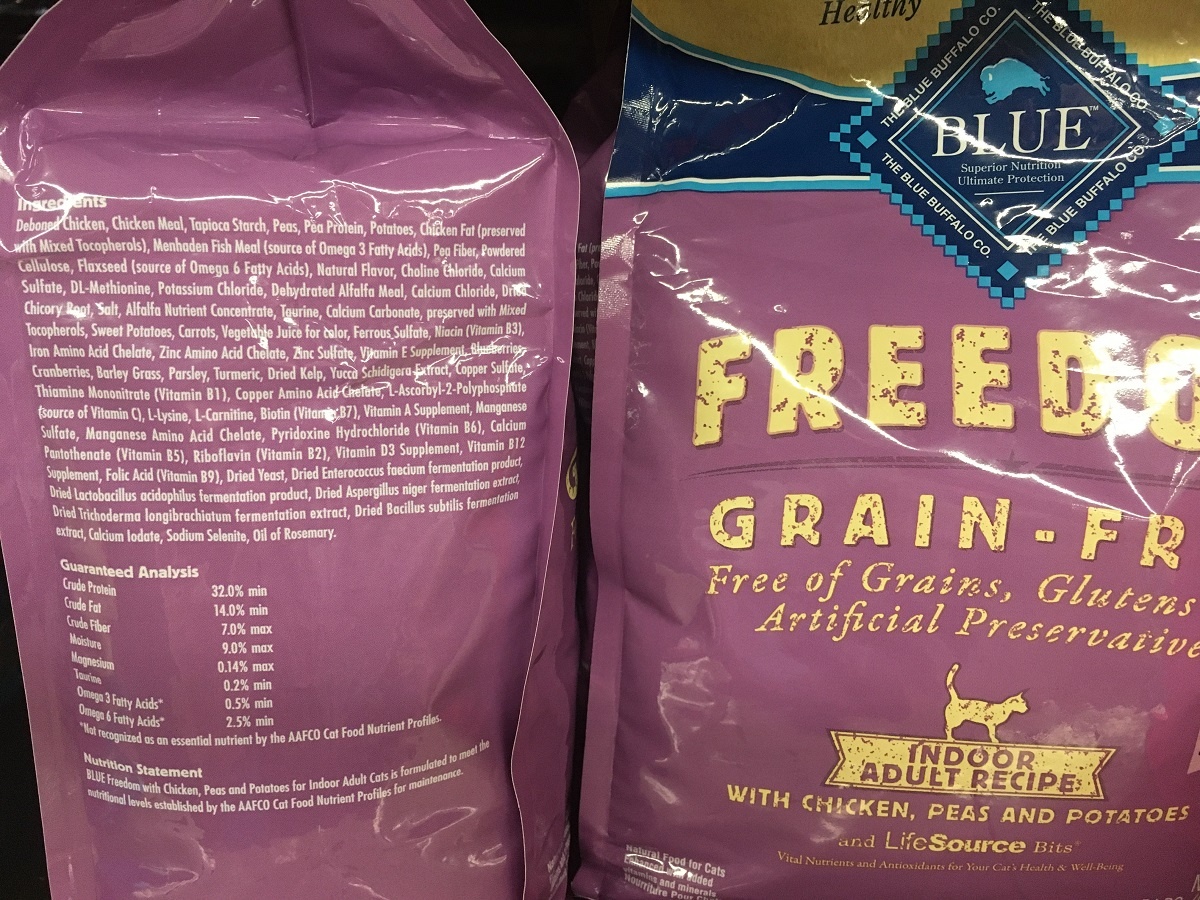
- Product name rule = with rule, 3% minimum requirement of meat, peas, and potatoes combined
- Carb amount = approx 41% dry matter basis
- First 5 ingredients = Deboned chicken, chicken meal, tapioca starch, peas, pea protein
Free of grains and gluten.
But, again, grain-free does not mean carb-free.
Peas and potatoes have carbohydrates.
And peas and potatoes are listed on the product name in the same size font as the chicken.
So these ingredients are grouped in the product name rule.
And the minimum requirement is 3% of these ingredients combined. And that maximum doesn’t pass 24.9%.
Otherwise, it would say dinner, recipe, platter, entree, etc. in the product name.
Blue Basics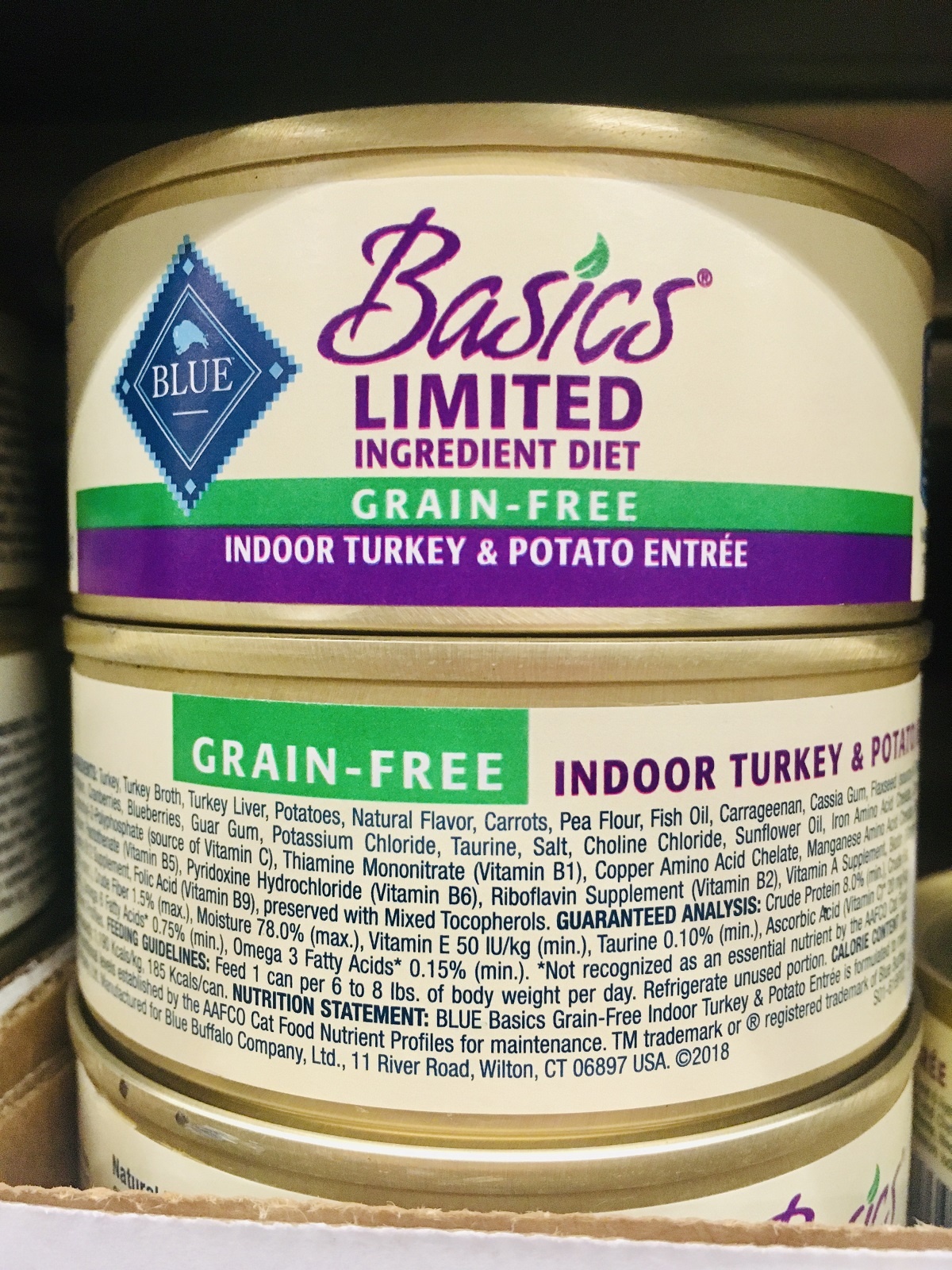
- Product name rule = entree rule, 25% minimum requirement of meat and potatoes combined
- Carb amount = approx 29% dry matter basis
- First 5 ingredients = Turkey, turkey broth, turkey liver, potatoes, natural flavor
Here’s another grain-free cat food full of carbs.
It says limited ingredients…
But still contains questionable ingredients like carrageenan, cassia gum, guar gum, and mystery fish oil.
Blue Wilderness
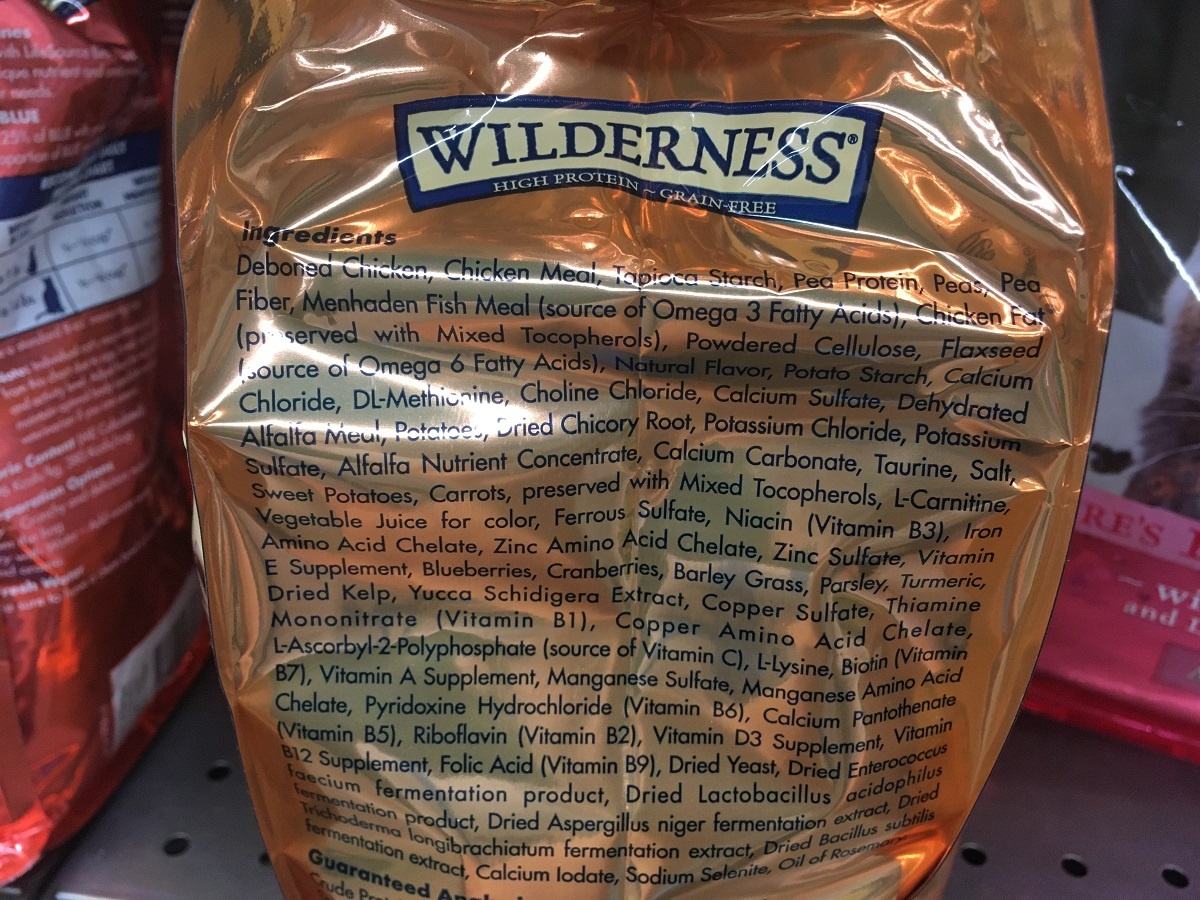
- Product name rule = with rule, 3% minimum requirement of meat
- Carb amount = approx 40% dry matter basis
- First 5 ingredients = Deboned chicken, chicken meal, tapioca starch, pea protein, peas
This one says high-protein and grain-free. The brand is called Wilderness.
It’s gotta be fit for carnivores, right?
Nope.
40% carbohydrates.
Powdered cellulose, a bunch of pea products, potato starch, flaxseed, dried yeast, and so on.
NOT part of a cat’s natural diet.
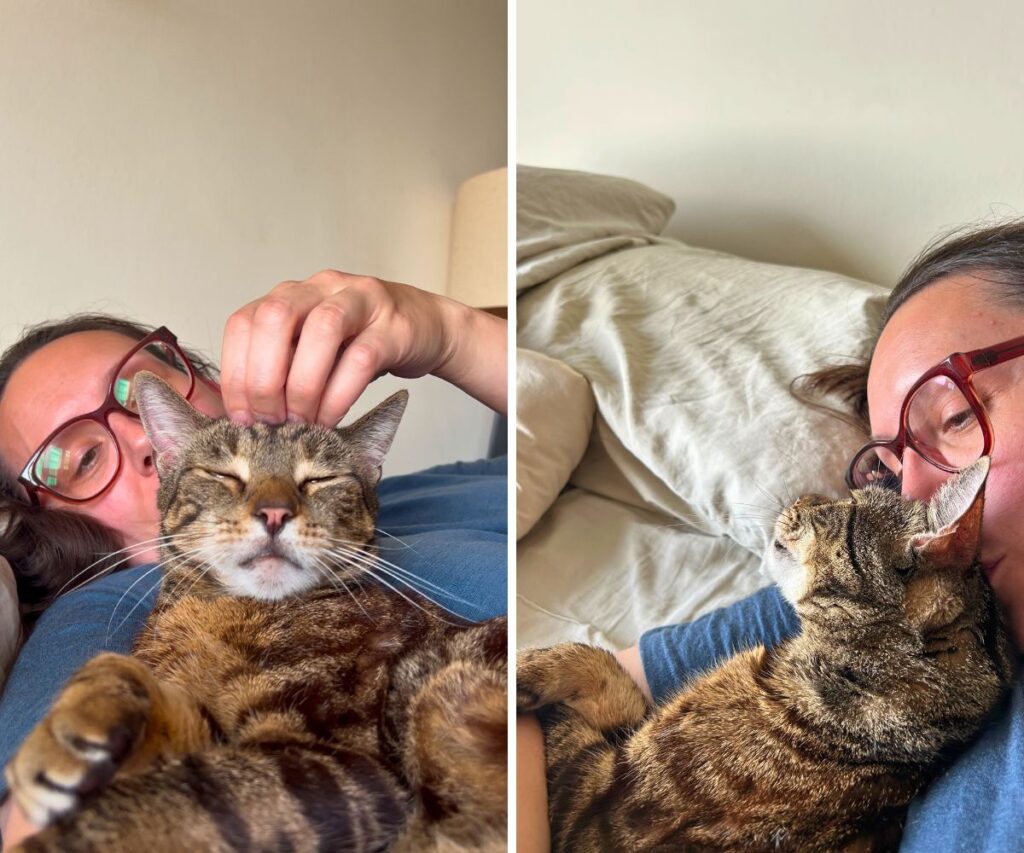
Final thoughts on worst cat food brands
The worst cat food brands are the most popular brands because multi-billion-dollar companies back them. These are the same companies that make junk food for humans. They use low-quality ingredients that are not appropriate for our cats.
I avoid these brands because I’ve learned the hard way over and over with cats in my life, both personally and professionally. That’s exactly why I recommend a healthy raw or gently cooked diet for all cats.
Common objections to feeding a healthy diet
I’m grateful that you’ve made it this far! Nutrition and reading labels are very exciting for me. But I understand that it can feel overwhelming when it’s new. Also, I’m sure you have doubts. So let’s address that.
My cat is too picky to eat healthy food
Cats are cautious (not picky!) about new foods. This is a survival instinct that all cats have. Additionally, dry food and many canned foods are addicting because of the high carb amount and flavor enhancers. Read more about why your cat is picky.
Healthy food is too expensive
It’s true that healthy food costs more than a 16-pound bag of dry food. But that’s like comparing a box of cereal to a healthy steak. Cats are carnivores who need to eat meat, not carbs. Feeding an unhealthy diet can and most likely will lead to health issues. So I see the cost of healthy food as an investment in my cat’s health.
The last time my mom left dry food out, her male cat got a urinary blockage. Charlie had to spend a week in the hospital, and it cost over $8,000. My dad had to take money out of his 401K to pay for it.
So spending a bit more on healthy food is worth it to avoid costly and painful health issues like this. Read the cost of homemade cat food to see the comparison of the best of the best options.
How to feed your cat a healthy diet:
- Learn about cat nutrition and how to read cat food labels so you don’t have to rely on me or anyone else to tell you what to feed your cat (I understand not everyone has time for this so skip to the next step if that’s you)
- Choose from the best high protein low carb wet food list (if you’re not comfortable with raw)
- Read through my raw feeding cats guide (if you are ready for raw) to see which raw diet is best for you
- Use my how to transition cat food guide so your cat actually eats the new food you buy
Thank you for reading this very detailed post!
You searched for this because you know there are better options out there. You know that your cat shouldn’t be eating dry meat-flavored granola for every meal, every day, for his entire life.
Please know that this is a journey and not a race. Take it slowly because that’s what your cat prefers and deserves. I’m excited for you to get started!
Ready to switch to raw for a happier cat?
Grab my Raw Feeding Blueprint and get the same plan that 564+ cat parents used to switch to a healthy raw diet easily and confidently. Plus 50+ balanced raw recipes, meal prep tips, and so much more!
